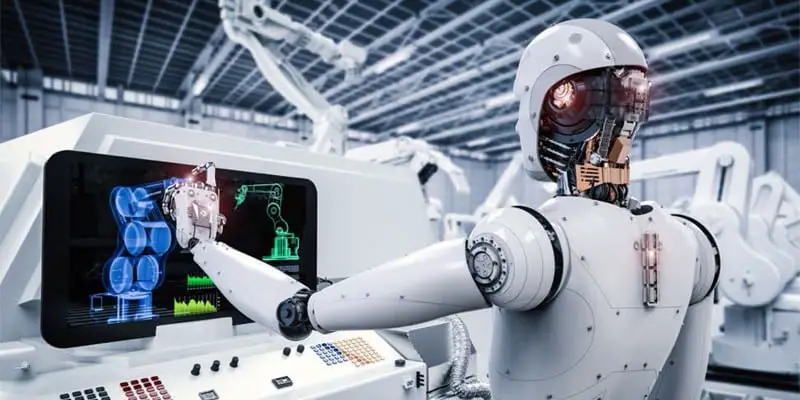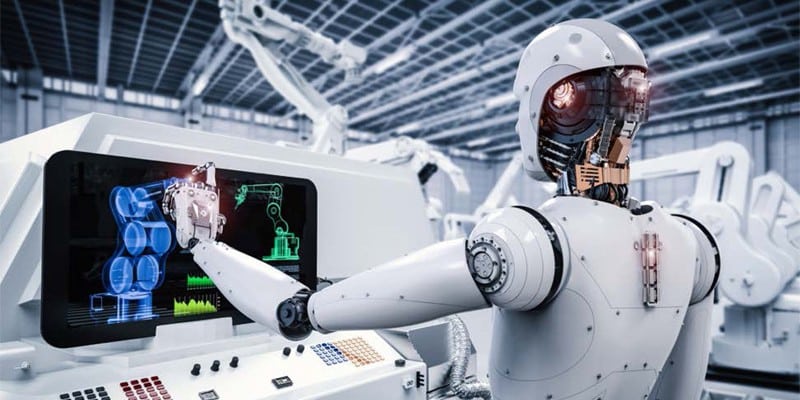
Introduction:
In the face of the rise of artificial intelligence and computer vision has become a critical part of applying the technology to everyday problems. Computer vision robotics is one of the most used AI techniques to improve human performance.
In this blog post, we’ll explore the current state of computer vision robotics, including its existing applications and future direction. We’ll also discuss recent advances in automated AI projects and what future holds for this advanced technology.
Table of contents
Also Read: The internet of everything – Our relationship with the internet
What are computer vision and AI?
It is important to remember that computer vision is different from artificial intelligence. They are not the same kind of technology, even though they aim to make our lives simpler and more accessible. In the field of computer science known as artificial intelligence, robots display behavior that seems to imitate human intellect.
This entails making choices based on how we humans would evaluate a situation, picking up the language, conversing with people and other robots, and even coming up with original solutions to issues.
Meanwhile, computer vision enables computers to observe their surroundings. In this case, artificial intelligence (AI) advances in image processing software, a task that computers are already capable of performing.
The Impact of Computer Vision on the World
Across many sectors, computer vision self driving cars is improving the convenience and ease of our lives. Giving mobile devices the capacity to detect products based solely on photos will facilitate more efficient buying experiences in the retail sector.
It is used in medicine to evaluate X-rays, MRIs, and other medical imaging, giving a computer’s perspective on information that would otherwise be unattainable. Self-driving cars like Tesla actively exploit computer vision to enhance current sensors to ensure a safe and effective trip.
Here are some of the most innovative uses of computer vision that I discovered after a few days of pacing the floor.
Computational sensing and low power processing
Advancements in computer vision technologies have profoundly impacted the field of robotics, particularly in the development of mobile robots. A key component of these advancements is the use of neural networks, a type of machine learning algorithm designed to mimic the human brain’s operation. Neural networks have proven to be exceptionally effective at tasks such as object recognition, which is essential for robots to interact effectively with their environment. By training a neural network on a vast array of images, robots can be taught to identify objects within their surroundings, thereby increasing their autonomous functionality.
Another crucial element in robotic vision is the ability to perceive a full view of the surrounding environment. The use of omnidirectional images offers a solution to this need, providing a 360-degree view that enables robots to better navigate and interact with their environment. With the incorporation of simultaneous localization and mapping (SLAM) technologies, mobile robots can leverage omnidirectional imaging to construct or update a map of an unknown environment while keeping track of their current location. This makes it possible for robots to operate in complex, dynamic environments and perform tasks with higher degrees of autonomy.
Despite the computational intensity of these tasks, the demand for low power processing in mobile robots remains a significant concern. Developing an efficient alternative to traditional, power-hungry processors is crucial to ensure that robots can operate for extended periods without the need for frequent recharging. One possible solution is to incorporate specialized hardware designed for machine learning tasks, such as custom neural network accelerators, which can perform the necessary computations more efficiently than general-purpose processors. Combining such technologies with distinctive image features that reduce the computational load can further optimize power usage. As we continue to push the boundaries of what’s possible with computer vision technologies in robotics, the focus will remain on creating solutions that balance computational prowess with energy efficiency.
Individualization
Future face recognition technology will significantly improve bespoke automobile settings. The Panasonic Chrysler Portal concept car has cameras outside and behind the steering wheel that utilizes computer vision to identify the driver as soon as they approach the vehicle and update music selections, sitting position, temperature, and other information.
Interfaces
Eye-tracking technology driven by computer vision has expanded beyond gaming laptops into consumer and commercial PCs, giving users who are unable to use their hand’s control.
Equipment
An aftermarket camera and app that uses image recognition to alert you when you’re running low on certain items can be retrofitted into your old refrigerator, which is truly game-changing. Expensive refrigerator cams that show you video footage of what’s in your refrigerator aren’t that revolutionary.
Autonomous vehicles
The automobile industry is where computer vision is used most prominently since it is one of the key enabling technologies for wholly and partially autonomous vehicles. With the NVIDIA Drive PX 2, a self-driving car reference platform that “Tesla, Volvo, Audi, BMW”, and Mercedes-Benz are already using for semi- and fully autonomous functions, NVIDIA, which already assisted in supercharging the profound learning revolution with its deep learning GPU tools, is powering many of the independent car innovations.
Not only the driver is “known,” but also the passengers, who may have their face-recognition-enabled customization settings for things like seating, temperature, and even noise-canceling “cocoons” that play their preferred music.
Also Read: AI and Autonomous Driving
LiDAR
LiDAR, or Light Detection and Ranging, has become a pivotal technology in the world of robotics, primarily for its use in autonomous vehicles and mobile robot localization. By emitting light pulses and measuring the time it takes for the light to return after hitting an object, LiDAR creates detailed, three-dimensional maps of the environment. However, to make sense of the massive amounts of data generated by LiDAR sensors, it’s essential to use advanced pattern recognition and machine learning techniques, including Speeded-Up Robust Features (SURF) and unsupervised learning algorithms.
SURF, an algorithm used for detecting and describing local features in images, helps identify the elementary features in the point clouds of data generated by the LiDAR sensors. When coupled with unsupervised learning algorithms, these elementary features can be used to identify objects and their spatial relationships in the robot’s surroundings. This ability becomes particularly crucial for visual navigation in indoor environments, where lighting conditions can vary drastically, and the presence of many objects can make navigation challenging. By converting the point clouds into binary patterns or spherical images, the algorithm can help ensure efficient robot localization, even in complex environments.
The model for robot localization also depends heavily on image plane processing. To understand the robot’s position and orientation, it’s important to project the 3D point clouds onto 2D image planes. Image sensors integrated with LiDAR systems allow for this process, helping to generate accurate maps of the environment and enhancing the robot’s ability to navigate its surroundings effectively. As a result, the combination of LiDAR technology with computer vision algorithms and machine learning techniques allows for more accurate, efficient, and adaptable mobile robot localization, paving the way for even more advanced applications of robotics in the future.
RADAR
RADAR (Radio Detection and Ranging) is another essential technology used in robotics for detecting and measuring the distance and velocity of objects in the robot’s environment. However, when coupled with computer vision techniques, such as catadioptric vision, RADAR can become a powerful tool for mobile robot navigation. Catadioptric vision systems, which use mirrors and lenses to capture a wide field of view, can provide omni-directional vision capabilities to robots, allowing them to perceive their surroundings in 360 degrees.
Omni-directional vision, particularly using mirror omnidirectional systems that incorporate a hyperbolic mirror, offers an unprecedented field of view that is crucial for robust place recognition and vision-based navigation. By reflecting light from all directions towards a single focal point, a hyperbolic mirror enables the robot to capture a comprehensive view of its surroundings. This wide field of view, combined with the distance and velocity data provided by RADAR, allows for more effective and reliable environmental representations. These representations are vital for real-time local visual features extraction and can significantly enhance the robot’s ability to navigate its environment.
The integration of RADAR and catadioptric vision technologies can significantly improve topological localization, a critical aspect of mobile robot navigation. Topological localization involves determining the robot’s position within a map based on distinctive landmarks or features. By combining the broad view provided by catadioptric vision with the distance and velocity data from RADAR, robots can better recognize landmarks, determine their position, and navigate through their environment. These advancements highlight how the synergistic use of different technologies can push the boundaries of what is achievable in the field of robotics.
What does the Future hold for technology?
A fast-expanding topic in both studies and applications in computer vision. Research developments in computer vision are increasingly more quickly and directly applied to industry.
AI engineers use computer vision technologies to recognize, categorize, and even respond to things in real time. Typical tasks include image categorization, face identification, position estimation, and optical flow. Programming computer vision algorithms to carry out these tasks is the responsibility of computer vision engineers.
Conclusion: Computer Vision Technologies in Robotics
The development of computer vision technology is continuing as AI becomes more pervasive in our daily lives. Due to developments in cloud computing, Auto ML pipelines, transformers, mobile-focused DL libraries, and mobile computer vision applications, as this technology scales, there will be an increased need for experts in computer vision systems.
In 2022, as augmented and virtual reality (VR) applications advance, computer vision developers can expand their expertise into new fields, such as creating simple, effective ways to replicate and interact with physical things in a 3D environment. In the future, computer vision robotics applications will likely continue to develop and have an impact.











